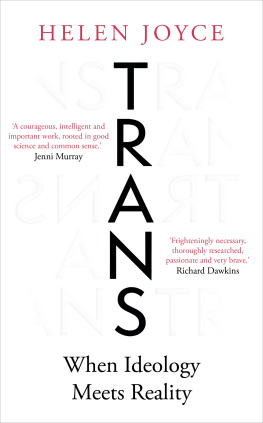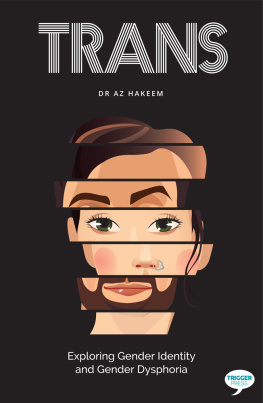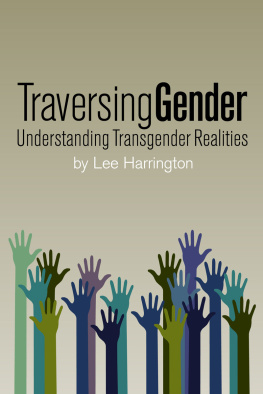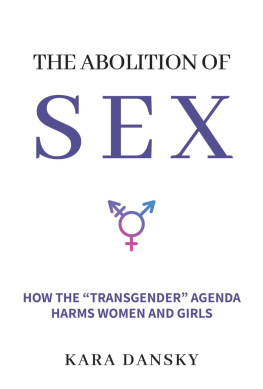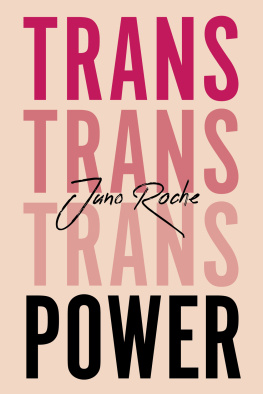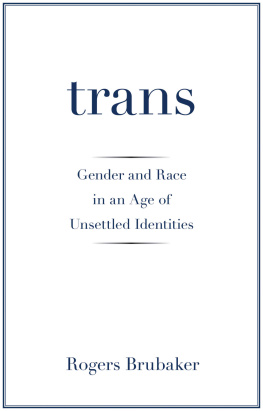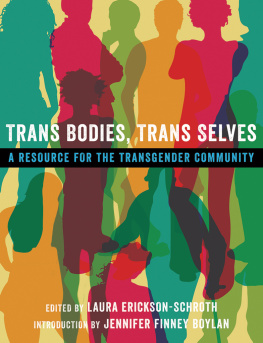Acknowledgements
My deepest gratitude goes to my agent, Caroline Hardman, who picked up my proposal when others were too timid, and to my editor, Cecilia Stein, who not only has a spine of steel but provided invaluable guidance on matters of structure and tone.
I would like to thank the women of Vancouver and Toronto, who helped me understand Canadas erasure of sex-based rights, and the women of gender-critical Twitter, who responded with wit and insight to my many questions. I learned a great deal from other women who use their media platforms to write about the harms of gender-identity ideology, in particular Jo Bartosch, Julie Bindel, Sarah Ditum, Madeleine Kearns, Victoria Smith and Janice Turner. I was inspired by the staunchness of Stephanie Davies-Arai, Maya Forstater, Jane Clare Jones, Meghan Murphy, Kathleen Stock and Nicola Williams, and by the generosity of spirit of Nick Cohen, Simon Fanshawe, Jon Kay and James Kirkup.
And finally, I salute the women responsible for the resurgence of grassroots feminism in the UK: FiLiA, Fair Play for Women, Womans Place UK, Legal Feminist, Sex Matters, For Women Scotland, MBM Policy Analysis and many others.
The Danish Girls
A brief history of transsexuality
It began with stockings. Gerdas sitter, the actress Anna Larssen, had telephoned to say she was running late for her portrait. Why not use Gerdas husband Einar, Anna suggested teasingly, as a substitute? After all, his legs were as good as Annas. The most perfect ladies model! cried Gerda, when she saw Einar transformed into... whom? What do you say to Lili? asked Anna, when she finally joined: A particularly lovely, musical name.
Whether this is truth or later mythmaking is impossible to tell. But certainly Einar Wegener an artist born in 1882 and trained in Copenhagen, and the Danish girl of the eponymous 2015 film starring Eddie Redmayne dated the birth of Lili Elbe (the surname was inspired by the river) to that extravagant joke. For years afterwards, Einar brought her out for portraits and parties. Hardly anyone knew that Gerdas sultry, sloe-eyed model was her cross-dressing husband.
The couple left Copenhagen to avoid exposure, and settled in Paris in 1912. Lili took to introducing herself as Gerdas sister. Over time, what had started as a game became deadly serious: the persona Einar now thought of as the woman in this body was gaining the upper hand. He went to doctors: they said he was mad or homosexual, which bothered him more. By his late forties, he was despairing. Within the following year, he decided, he would either find a way to give permanence to Lilis existence or end Einars.
The year was nearly up when Lili was thrown a lifeline. In February 1930, Einar visited the Institute of Sexual Science in Berlin, where he consulted its founder Magnus Hirschfeld. The Institute combined research with practical services, such as treatment for venereal disease, impotence and infertility. It had an archive like no other. In his memoir of Weimar-era Berlin, Christopher Isherwood recalled its whips and chains and torture instruments designed for the practitioners of pleasure-pain; high-heeled, intricately decorated boots for the fetishists; lacy female undies which had been worn by ferociously masculine Prussian officers beneath their uniforms.
For Wegener, who felt like twin people of opposite sexes inhabiting a single body, Hirschfelds way of thinking about what distinguished men and women could not have been more congenial. According to the ancient one-sex model, men and women were essentially similar, except that womens reproductive anatomy was inverted and inferior. Women have exactly the same organs but in exactly the wrong places, wrote Galen, a Greek physician of the second century. By the nineteenth century, as the study of anatomy advanced, this had been supplanted by a two-sex model, in which male and female were understood as separate categories. In the early twentieth century, however, Hirschfeld and a handful of other European sexologists were developing a new model. Surprisingly, their theories were uninformed by, and impossible to reconcile with, evolutionary theory and Charles Darwins insights into the origin and significance of the two sexes. That foundational error is still visible in much thinking about what it means to be transgender today.
In The Origin of Species , published in 1859, Darwin explained the two types of selection that drove evolution: natural and sexual. In the former, it is differential survival rates that cause reproduction rates to vary; in the latter, it is differential success in attracting mates. The theory of evolution underpins all modern biological and medical science, and understands the sexes as ancient categories: reproductive roles shaped by and directed towards survival and reproduction. Male body parts are those directed towards the production of small, motile gametes (in animals, called sperm), and female ones are those directed towards the production of large, immotile gametes (in animals, called ova, or eggs).
Whether an individual has parts of just one sex or both depends on the species. Many plants are self-pollinating, and a single specimen contains both male and female parts. Some animals earthworms, for example are hermaphrodites, possessing both male and female sex organs. Others, such as crocodiles and clownfish, have the potential to develop into individuals of either sex in response to environmental cues. But for humans, as for all mammals, individuals are of one sex or the other, and that sex is immutable and determined at conception. The existence of intersex conditions or disorders of sex development (DSDs) an umbrella term for around forty different developmental conditions of the genitalia and gonads does not alter this. I will have more to say about these conditions in later chapters.
After Darwin, any definition of male and female other than as developmental pathways directed towards and shaped by reproductive roles should have been dead in the water. But for Hirschfeld and his colleagues at the Institute, it was as if Darwin had never existed. Not only did they ignore the origin of the sexes, they did not even regard them as distinct categories. In Hirschfelds phrase, all people were bisexual, not in the sense of being attracted to both sexes, but in the sense of being both sexes. Male and female, Hirschfeld wrote, were abstractions, invented extremes. Homosexuals and transvestites Hirschfelds word for anyone from part-time cross-dressers to people with a strong, unremitting identification with the opposite sex were simply intermediate types, unusually far from those notional end-points.
For someone like Wegener, who wanted to change sex, these ideas were appealing. If the sexes were distinct and non-overlapping, how could you move from one to the other? But if sex was a spectrum, then perhaps you could move far enough along it to be reclassified.
By the time he met Hirschfeld, the Institute had already been experimenting along these lines with genital surgery. Its earliest known patient was Dora (Rudolph) Richter. Born in 1891 to a poor farming family, Rudolph had cross-dressed from very young, and at age six attempted to remove his penis and scrotum with a tourniquet. Under the care of the Institute, in 1922 Rudolph was castrated and in 1931 underwent penectomy and the construction of an artificial vagina. Dora stayed on at the Institute as a demonstration patient and maid.
For Wegener, Hirschfeld wanted to try something more ambitious: a transformation of body chemistry as well as genitals. He was inspired by the work of Eugen Steinach, an Austrian endocrinologist who transplanted testicles into baby female guinea pigs, and ovaries into baby male ones, in the hope of inducing behaviours characteristic of the donor sex. He set Wegener on a gruelling series of operations. First came castration and penectomy, as with Richter; then the implantation of ovaries removed from a young woman; and finally the construction of a natural outlet probably a neovagina crafted from uterine tissue, or possibly an attempt at a womb transplant.
Next page
